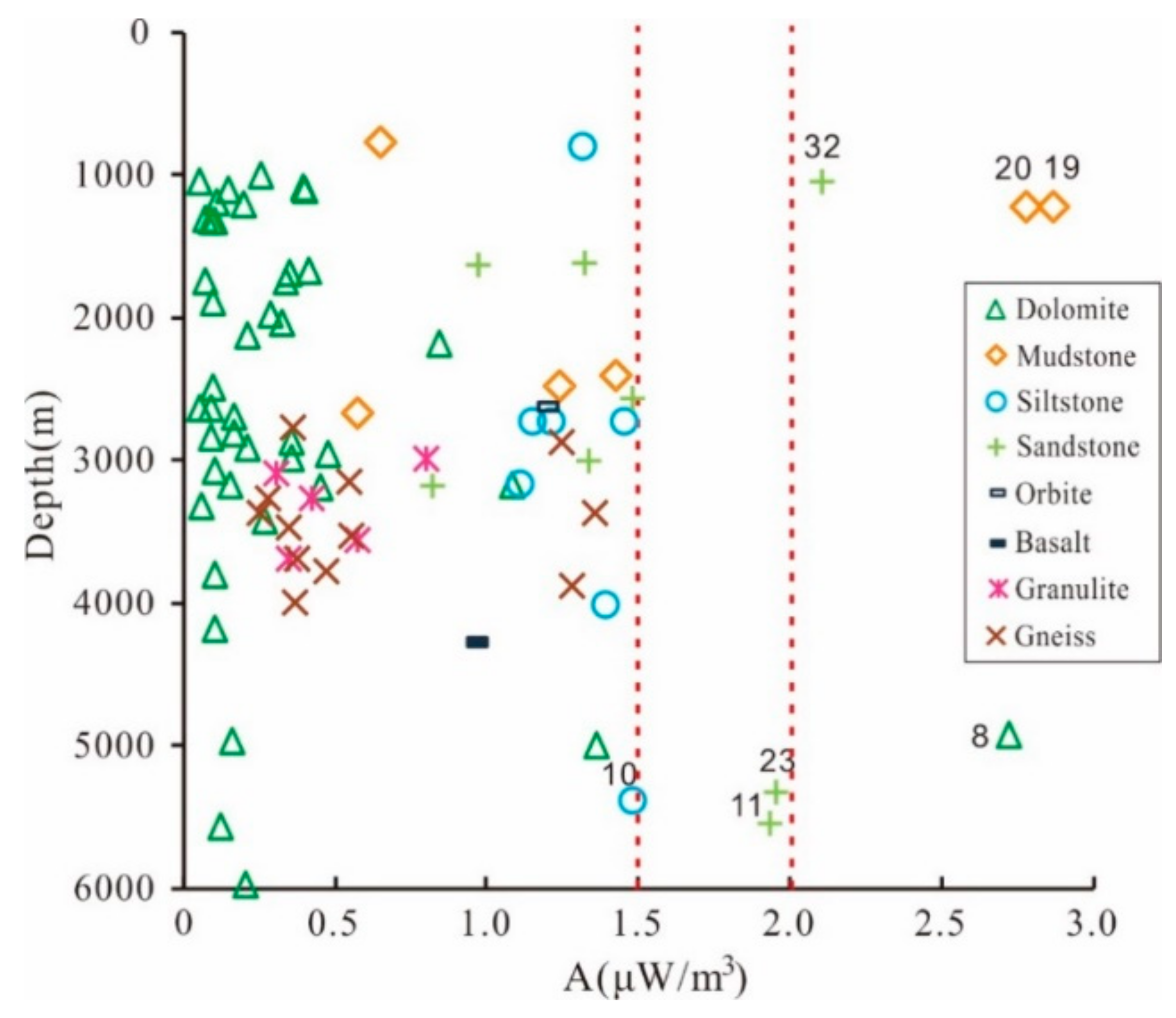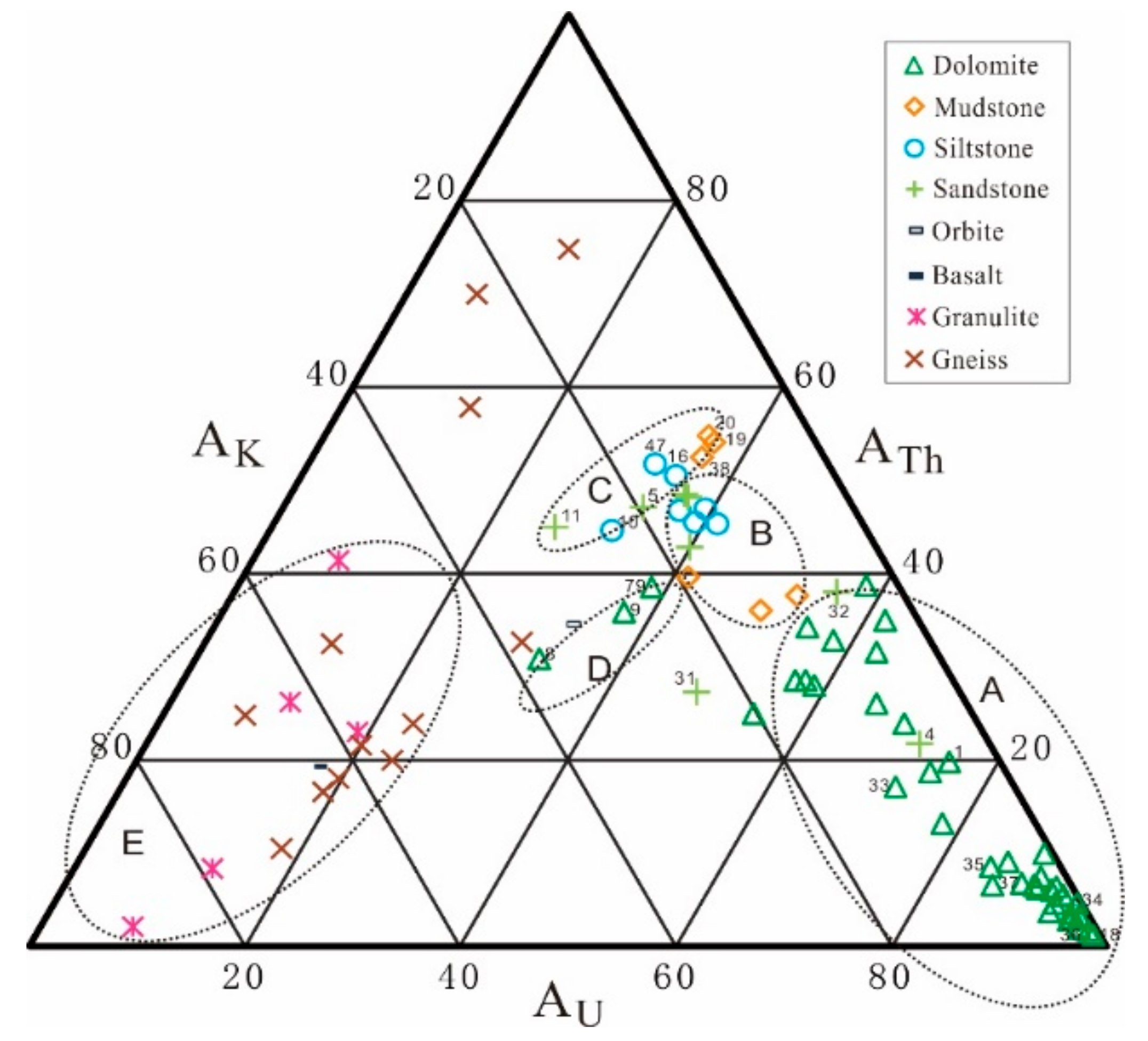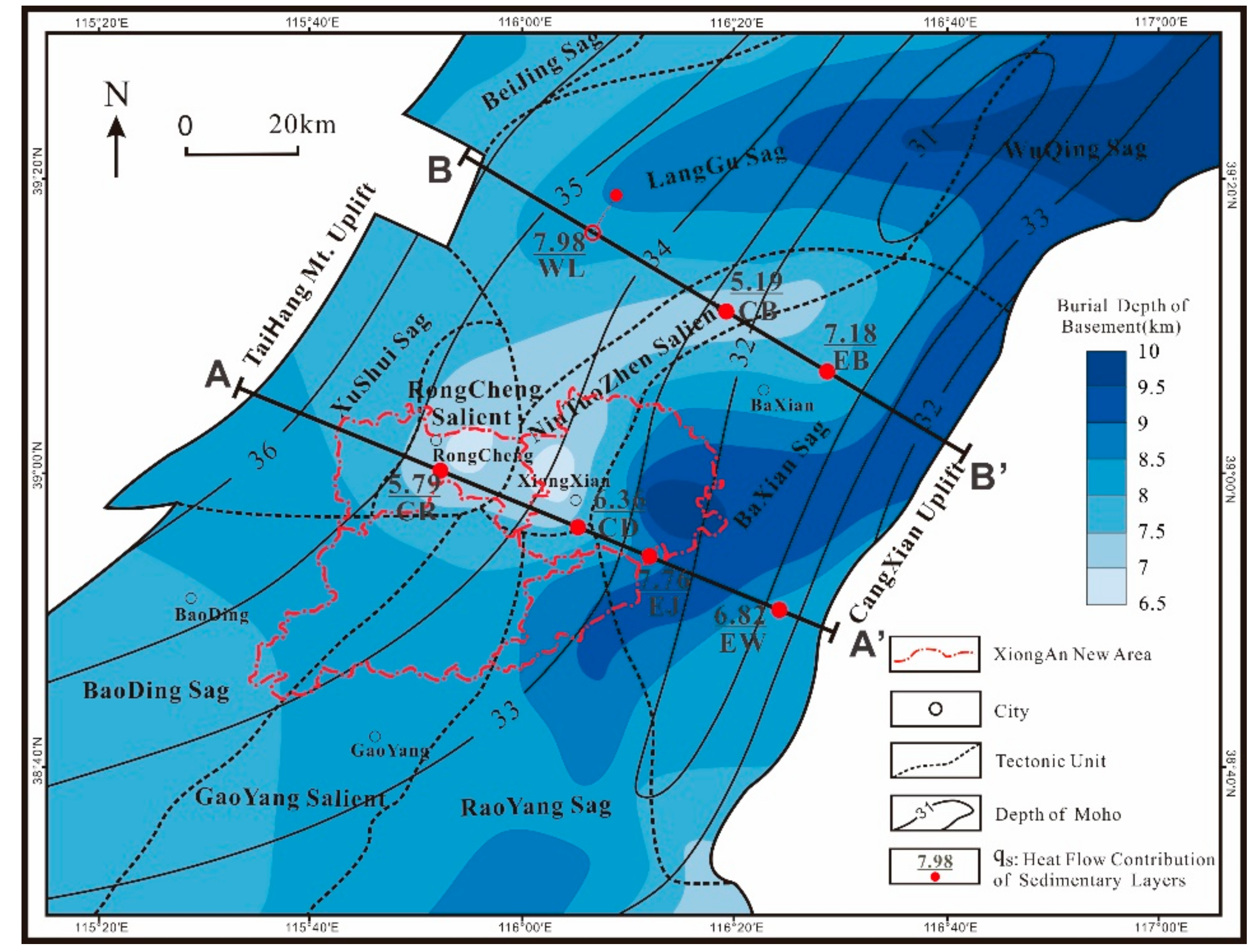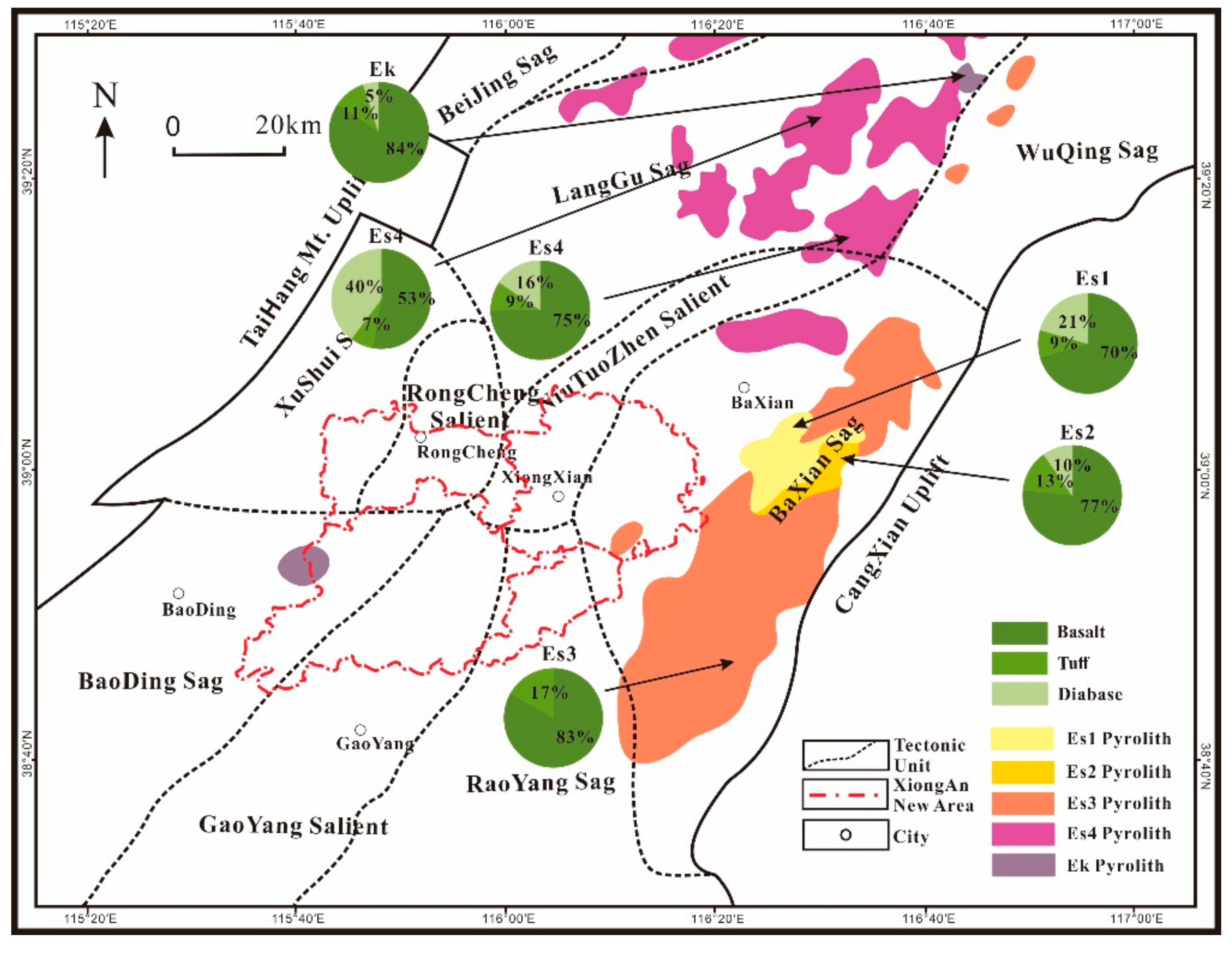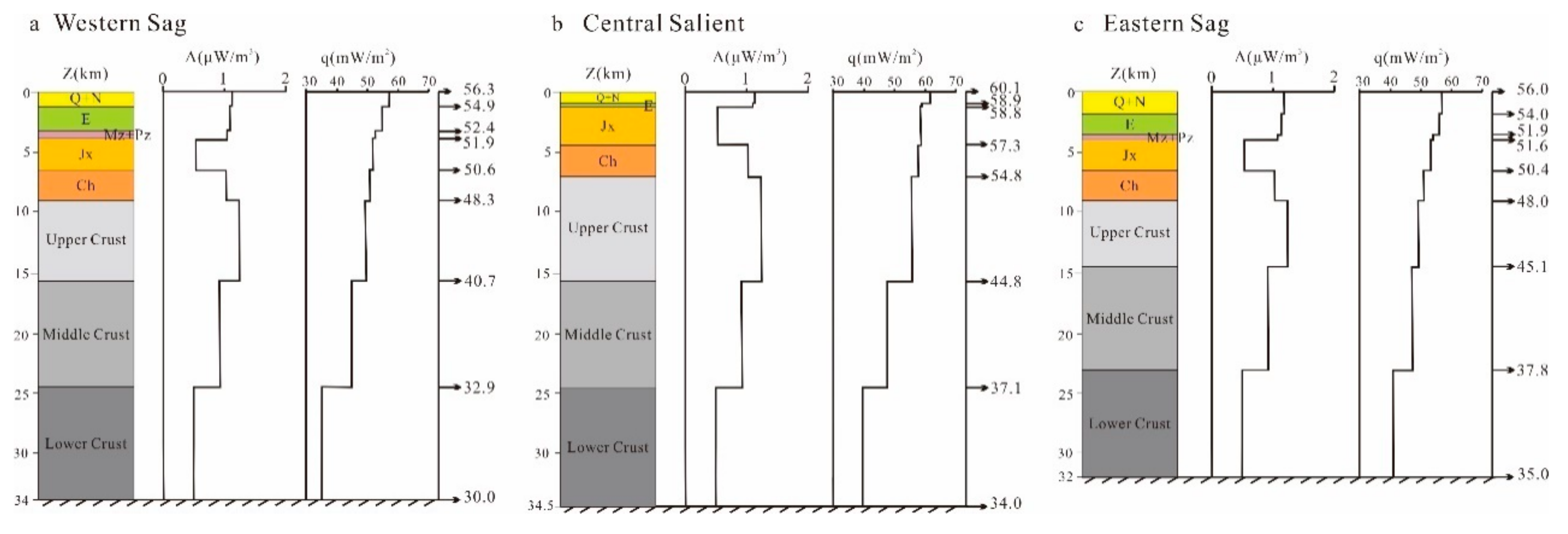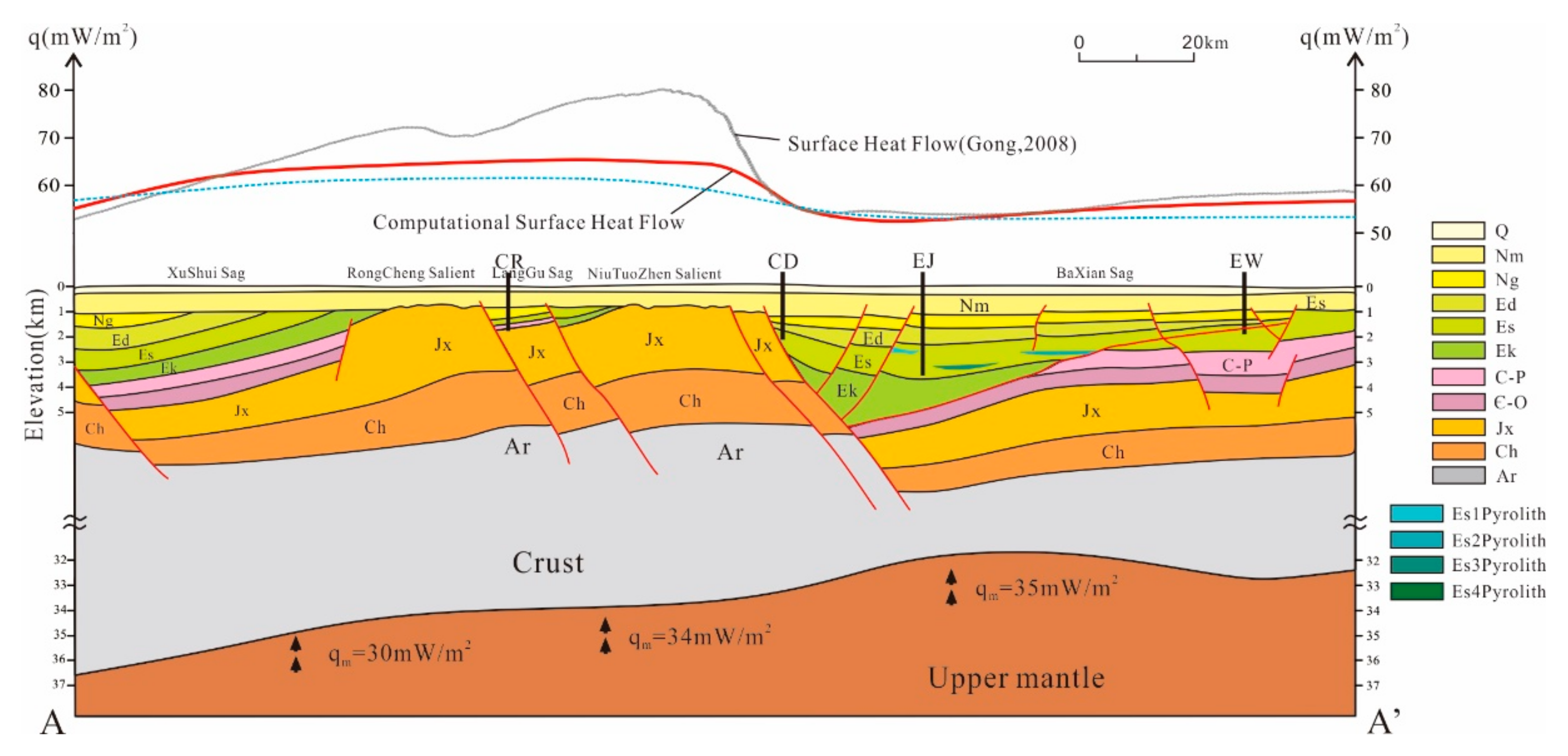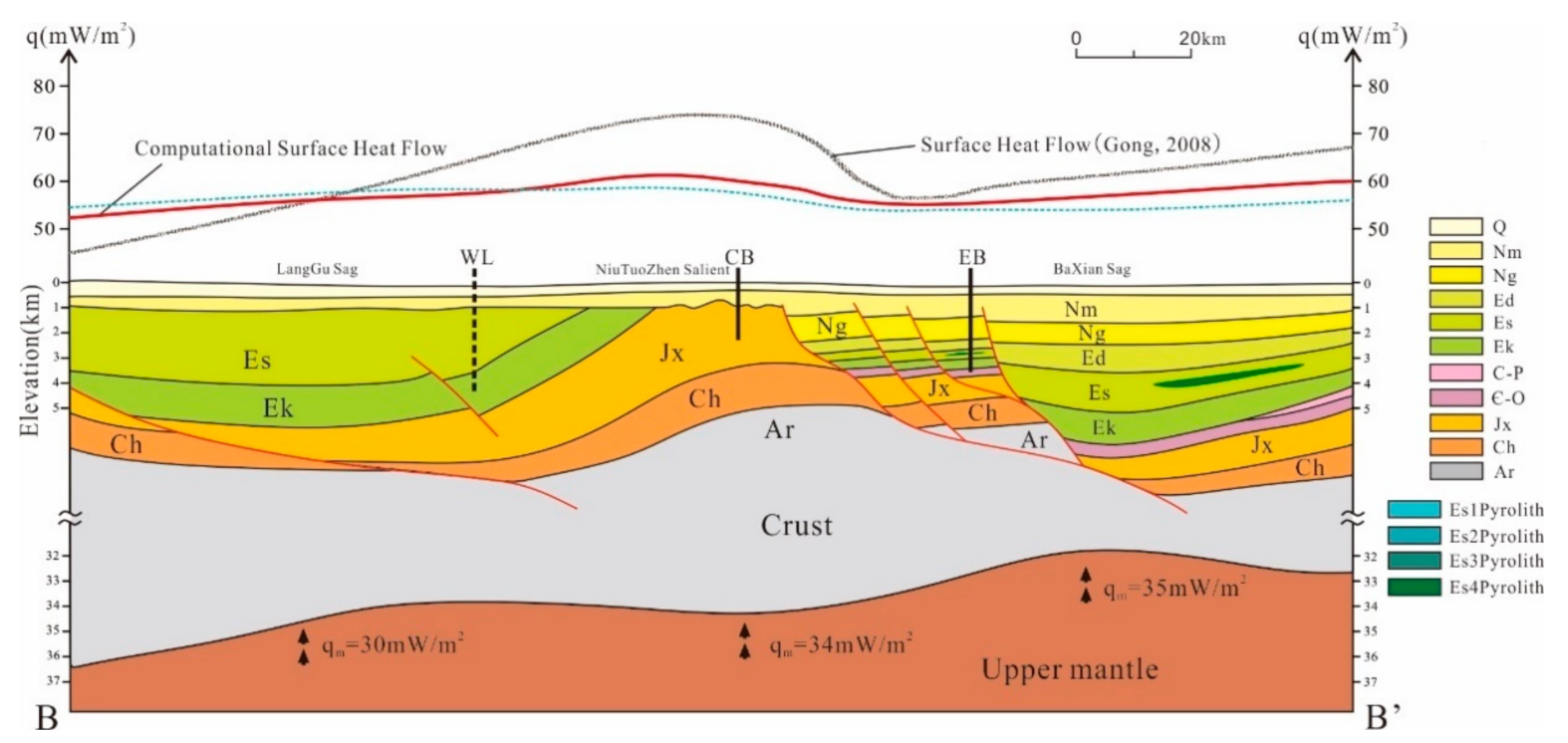3. Radioactive Heat Production of Sedimentary Rocks, Pyrolite, and Metamorphic Rocks
Heat production was calculated using the empirical formula proposed by Rybach [
21] shown in Equation (1)
where A is radioactive heat production (μW/m
3), ρ is rock density (kg/m
3), and C
U, C
Th, and C
K represent the contents of U (mg/g), Th (mg/g), and K (wt %), respectively.
The HPE concentration and calculated heat production of each sample is listed in
Table A1, and the relation between heat production and depth is shown in
Figure 2. Most samples have heat production values lower than 1.5 μW/m
3 with only six samples (7%) having heat production values greater than 1.5 μW/m
3 and 95% are lower than 2 μW/m
3. There is no significant correlation between heat production and depth. The heat production values of mudstone, siltstone, and sandstone are similarly distributed, whereas marine sandstone and mudstone (samples from the Proterozoic) have an obviously higher distribution. Heat production is lowest in dolomite, although that of the dolomite with high argillaceous content sample (No. 8) is relatively higher.
Additionally, different lithologies showed varying heat production distributions. Four of the six mudstone samples had heat production values lower than 1.5 μW/m3, whereas two (nos. 19 and 20) had heat production values greater than 2.5 μW/m3. Sandstone samples with heat production values of 0.5–1, 1–1.5, and 1.5–2 μW/m3 were almost equal in number at 25% (2/8), 37% (3/8), and 25% (2/8), respectively, and the remaining sandstone sample’s heat production value was 2–2.5 μW/m3. Although the dolomite samples had relatively scattered distribution, samples with heat production values lower than 0.5 μW/m3 made up 88% (38/43) of the total dolomite samples, and those lower than 1.5 μW/m3 made up 97% (42/43) of the total with only one sample greater than 2.5 μW/m3. All the siltstone samples had heat production values of 1–1.5 μW/m3. Pyrolith samples were sparse, and the average heat production values of basalt and orbite were 0.94 and 1.17 μW/m3, respectively, and were concentrated at 0.5–1.5 μW/m3. The heat production values of granulite and gneiss in basement metamorphic rock samples were mainly distributed around 0–0.5 μW/m3, making up 60% (3/5) and 58% (7/12) of these samples, respectively. Additionally, 40% (2/3) and 17% (2/12) of the granulite and gneiss samples, respectively, were distributed at approximately 0.5–1 μW/m3, whereas the remaining 25% (3/12) of the gneiss samples were distributed at approximately 1–1.5 μW/m3.
Heat production is a basic rock thermal characteristic that typically has a strong correlation with lithology, i.e., carbonate rocks usually have lower heat production values than clastic rocks, basic igneous rocks usually have lower heat production values than that of intermediate acidic igneous rocks, and basement metamorphic rocks have heat production values between those of clastic and carbonate rocks. However, heat distribution within the same lithology can also be scattered. Therefore, before calculating heat production characteristics of the same lithology, further analysis of heat production, such as the contribution of various radioactive elements, is necessary.
Figure 3 shows that the heat production of Th in sedimentary rocks, such as sandstone, siltstone, and mudstone, is higher than that in dolomite. In marine clastic facies (nos. 10, 11, 19, and 20), Th heat production is similar and U heat production is relatively higher in marine clastic rocks than that in continental clastic rocks. Heat production of K in basal granulite and gneiss are obviously higher than that in sedimentary rocks. Dolomite samples, continental clastic rock samples, marine clastic rock samples, metamorphic rock samples, and dolomites with high argillaceous content were mostly distributed in Groups A, B, C, E, and D, respectively. In Group A, sedimentary rock samples comprised mainly of continental and marine dolomites. Examples include sample nos. 33–37, which were lacustrine dolomites developed in the Nm and Ed with heat production characteristics similar to those of marine dolomites and relatively low heat production. Clastic rocks in Groups B and C had relatively high heat production, whereas those of marine clastic rocks in Group C were higher than those in Group B. Examples include nos. 10 and 11, which were siltstone and quartz sandstone samples in well GS1 in the Changcheng system, and nos. 19 and 20, which were mudstone samples in well N28 in the Jixian system. Sample nos. 8, 9, and 79 in Group D were argillaceous dolomite samples developed in the Changcheng system. Samples in the Changcheng system typically had higher argillaceous content and greater heat production than dolomite samples in Group A, but were lower than Groups B and C clastic rock samples. The Group E samples contained basalt, indicating that the basalt composition was mainly from deep material upwelling caused by plate tension and thinning. The heat production values of basic igneous rocks were lower than those of neutral igneous rocks, and their radioactive element contents were similar to that of gneiss.
The vertical distribution and element ratios of U, Th, and K (Th/U and Th/K) reflected sedimentary ages and environments [
22,
23,
24,
25,
26]. U was easily oxidized during deposition, with U
4+ being oxidized to U
6+ and forming free oxide [UO]
2]
2−, which has good water solubility and is prone to migration, whereas thorium did not have this property. Therefore, the Th/U ratio can indicate a paleoenvironment’s redox state. In an oxidizing environment, the Th/U ratio is greater than six, whereas in a reducing environment, it is less than two [
27,
28]. K is not easily enriched in sediments owing to its activity; therefore, K in sedimentary rocks is usually related to clay mineral and K mineral contents in the provenance area. Generally, the potassium content is higher in shallow near-shore water and lower in the open ocean [
29]. Therefore, the Th/K ratio can indicate changes in water depth. The Th/K ratio of long-term weathered sediments is greater than seven, whereas that of a deep-water low-energy environment is relatively low [
30,
31].
Calculations based on radioactive heat production data, the Th/U ratio of continental clastic rocks is calculated as 3.2 (R
2 = 0.68) (3–6) and Th/K ratio is 3.9 (R
2 = 0.11) (3–6), whereas that of marine carbonate rocks is 1.4 (R
2 = 0.41) (1–2) and Th/K ratio is 1.3 (R
2 = 0.87) (1–2). Thus, the rock samples were classified based on heat production contributions of radioactive elements. As shown in
Table 2, the Th/U and Th/K ratios gradually decreased from sandstone to mudstone to dolomite in marine sedimentary rocks, i.e., clastic rocks deposited in an oxidizing environment of relatively shallow water and carbonate rocks deposited in a reducing environment of deep water. In continental sedimentary rocks, the Th/U ratios of mudstone and siltstone belong to the median area; however, the sandstone ratio changes the most and is at the upper limit of the Th/U ratio, indicating that the rock grain size change in continental sediments reflected different sedimentary facies zones, and the rule change of U, Th, and K also reflected the restriction effects of different sedimentary environments on their distribution [
29]. We calculated the average heat production and contributions of U, Th, and K in samples with different lithologies based on these sample classifications.
Table 2 shows the results of these calculations. The average heat production values of sandstone, siltstone, mudstone, dolomite, basalt, orbite, granulite, and gneiss were 1.43 ± 0.44, 1.27 ± 0.14, 0.97 ± 0.37, 0.34 ± 0.47, 0.94, 1.17, 0.49 ± 0.18, and 0.62 ± 0.40 μW/m
3, respectively. The marine clastic rocks samples had heat production values of 2.26 ± 0.58 μW/m
3. The marine dolomite samples had heat production values of 0.37 ± 0.49 μW/m
3, whereas that of the continental dolomite samples is 0.10 ± 0.06 μW/m
3. The heat production contribution of U, Th, and K in continental sedimentary rock samples was 51–72%, 22–37%, and 6–12%, respectively. These results are similar to those reported by Abbaby [
24], wherein thermal contributions of U, Th, and K were reported as 62%, 34%, and 4%, respectively, for continental sedimentary rocks in Egypt. In marine carbonate rocks, U was the main heat production contributor, accounting for 78% on average. In some samples, heat production was almost entirely from U. In basic igneous rocks (basalt), K is the main heat production contributor, whereas in neutral igneous rocks (orbite), U, Th, and K have similar heat production contributions and higher total heat production than basic igneous rocks. However, owing to the small number of samples, no specific analysis was conducted here.
The U, Th, and K contents of Archean metamorphic rock samples were 0.32 μg/g, 3.09 μg/g, and 2.8%, respectively, with an average heat generation rate of 16%, 29%, and 54%, and the Th/U ratio and Th/K ratios were 7.7 and 0.9, respectively (
Table 2). This result was not consistent with that of global crustal rocks studied by Huang [
32], which had U, Th, and K contents of 0.5–0.6 μg/g, 1.8–6.1 μg/g, and 0.6–1.9%, respectively. It was also not consistent with results on mainland China studied by Wang [
33], which had U, Th, and K contents of 0.83–1.76 μg/g, 3.16–6.69 μg/g, and 1.0–2.12%, and Th/U ratios of 3.8–5. We found that U and Th were affected by tectonic movements and migration owing to their activity, or that only metamorphic rock samples were selected in one well, which only represents a horizon of element abundance and heat production and cannot represent that of the entire upper crust [
34,
35,
36].
In conclusion, the sedimentary layer in the Xiong’an area had relatively low heat production. The average of all samples herein was 0.98 μW/m
3, which was close to the value of the Sichuan Basin sedimentary layer, i.e., 0.97 μW/m
3, calculated by Zhu et al. [
36]. However, this value is lower than previously calculated global average heat production values, such as 2.3, 2.1, and 1.9 μW/m
3 in the Phanerozoic, Mesozoic, and Cenozoic, as calculated by Huang [
32], Wang et al. [
13], and Qiu [
37], respectively. Additionally, the heat production values of sedimentary layers in the eastern China Basin and western Qaidam Basin ranged 2.0–2.2 μW/m
3, which is even lower than that of the Junggar Basin (1.137 μW/m
3), which was thought to have the lowest heat production [
38]. The Bohai Bay basin is a Mesozoic–Cenozoic superimposed rift basin in the eastern portion of the NCC that developed large scale basic volcanic rocks during the Yanshanian. Additionally, the relatively low heat production of dolomites and basic igneous rocks may also be one of the reasons for the low heat production in the Xiong’an area.
5. Conclusion
Most sedimentary rocks in the study area had heat production values of less than 1.50 μW/m3. The average heat production values of sandstone, siltstone, and mudstone are 1.43 ± 0.44, 1.27 ± 0.14, and 0.97 ± 0.37 μW/m3, respectively. The heat production of marine clastic rocks is slightly higher than that of continental clastic rocks, and dolomite’s overall heat production is lower, i.e., 0.34 ± 0.47 μW/m3. In continental sedimentary rocks, the contributions of U, Th, and K to heat production are 51–72%, 22–37%, and 6–12%, respectively. The low heat production is mainly related to the sedimentary environment and provenance.
The average heat production of the sedimentary layers in the study area is 0.81–1.06 μW/m3. The western sag produced the greatest contribution at up to 7.98 mW/m2, whereas in the central salient and eastern sag, it is 5.19–6.36 and 6.82–7.76 mW/m2, respectively. The contribution rates of heat production of the sedimentary layer for the western sag, central salient, and eastern sag are 13.02%, 6.04–9.68%, and 11.88–14.21%, respectively.
The Moho depths in the study area are 34, 34.5, and 32 km from west to east, respectively; the mantle heat flows are 30, 34, and 35 mW/m2, respectively; and the conductive terrestrial heat flows obtained by forward calculation are 56.3, 60.1, and 56 mW/m2, respectively. The differences between the conductive terrestrial calculated and measured heat flows are due to the disturbance of groundwater activities on the geothermal field. The crust–mantle heat flow ratios for the western sag, central salient, and eastern sag are 0.88, 0.77, and 0.6 respectively, which reveal a ‘cold crust-hot mantle’ type in the study area.

